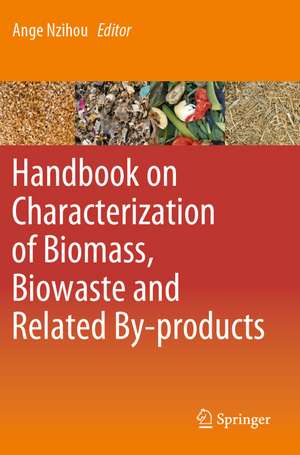Handbook on Characterization of Biomass, Biowaste and Related By-products
Editat de Ange Nzihouen Limba Engleză Paperback – 17 feb 2021
| Toate formatele și edițiile | Preț | Express |
|---|---|---|
| Paperback (1) | 773.48 lei 39-44 zile | |
| Springer International Publishing – 17 feb 2021 | 773.48 lei 39-44 zile | |
| Hardback (1) | 1145.10 lei 39-44 zile | |
| Springer International Publishing – 18 feb 2020 | 1145.10 lei 39-44 zile |
Preț: 773.48 lei
Preț vechi: 1004.52 lei
-23% Nou
Puncte Express: 1160
Preț estimativ în valută:
148.01€ • 154.85$ • 122.95£
148.01€ • 154.85$ • 122.95£
Carte tipărită la comandă
Livrare economică 31 martie-05 aprilie
Preluare comenzi: 021 569.72.76
Specificații
ISBN-13: 9783030350222
ISBN-10: 3030350223
Pagini: 1387
Ilustrații: XVI, 1387 p. 548 illus., 379 illus. in color. In 2 volumes, not available separately.
Dimensiuni: 155 x 235 mm
Greutate: 2.06 kg
Ediția:1st ed. 2020
Editura: Springer International Publishing
Colecția Springer
Locul publicării:Cham, Switzerland
ISBN-10: 3030350223
Pagini: 1387
Ilustrații: XVI, 1387 p. 548 illus., 379 illus. in color. In 2 volumes, not available separately.
Dimensiuni: 155 x 235 mm
Greutate: 2.06 kg
Ediția:1st ed. 2020
Editura: Springer International Publishing
Colecția Springer
Locul publicării:Cham, Switzerland
Cuprins
Introduction.- Chapter 1: Biomass categories.- Chapter 2: Lignocellulosic Biomass.- Chapter 3: Alkaline, Alkali Earth metals (AAEM), Transition metals and halogens.- Chapter 4: Microalgal biomass of industrial interest.- Chapter 5: Methods to assess biological transformation of biomass.- Chapter 6: MSW.- Chapter 7: Food waste and Manure.- Chapter 8: Sludges, dredged sediments.- Chapter 9: Biogas.- Chapter 10: Syngas.- Chapter 11: Condensables and liquid compounds.- Chapter 12: Dioxins and Dioxin-like Compounds from Biomass Combustion.- Chapter 13: Particle matter.- Chapter 14: Solid residues.
Notă biografică
Professor Ange NZIHOU (M) holds a PhD in Chemical Engineering, and is Director of the Research Centre for Particulate Solids, Energy and Environment (RAPSODEE – CNRS) at the IMT Mines Albi (France). He is a Distinguished Professor of Chemical and Environmental Engineering and Editor-in-Chief of “Waste and Biomass Valorization” (www.springer.com/engineering/ journal/12649), a peer-reviewed journal published by Springer Nature, and the founding Chair of the WasteEng Conference Series (www.wasteeng2020.org), an international bi-annual series established in 2005. He is Chair of WtERT-France (Waste to Energy Research and Technology Council) led by Columbia University (USA), and a member of the management team of the Global WtERT Council www.wtert.org). He is a Visiting Professor at a number of top universities in the USA, Europe, China, India and Malaysia. He is also a board member of leading peer-reviewed engineering journals and committees.
He has extensive expertise in fields such as energy and added value materials from biomass and waste; recovery of phosphate and inorganic elements from waste and biomass, recycling, functionalisation phosphate-based composites / hybrid materials (sorbents, fertilizers, catalysts, energy carriers, sensors) for energy, agriculture and depollution (liquid, gas, solid phases); thermochemical processes (pyrolysis, gasification, reforming) for biochar, bioash and energy production; the behavior of pollutants such as heavy metals and aerosols (fine particles) and kinetics and transfer phenomena. He has published 145 articles in peer-reviewed journals, 4 world patents (2 scaled-up at industrial level), co-edited 2 books on waste and environmental management and engineering fields, and presented 33 invited plenary and keynote lectures at international conferences. He has chaired and co-chaired 10 conferences and 2 international summer schools. He has obtained about 5.6 M€ of research grants over the 20 last years. He is Chair and principal Investigator of 3 joint Laboratories with industry.
He has received international and national awards such as the Grand Prix 2018 of the Academy of Sciences of France for his outstanding contributions in science and technology of energy transition. He was also made an Erudite Professor of the Mahatma Ghandi University (India) in 2018. He was appointed as a member of the scientific advisory board of the World Bank PASET program (Partnership for skills in Applied Sciences, Engineering and Technology) Scholarship in Innovation Fund in 2018. He was also made a Knight of the National Order of Merit (France) in 2017. He has frequently worked as an adviser and evaluator for EU projects under the FP7 and H2020 framework programs.
Textul de pe ultima copertă
This book provides authoritative information, techniques and data necessary for the appropriate understanding of biomass and biowaste (understood as contaminated biomass) composition and behaviour while processed in various conditions and technologies. Numerous techniques for characterizing biomass, biowaste and by-product streams exist in literature. However, there lacks a reference book where these techniques are gathered in a single book, although such information is in increasingly high demand. This handbook provides a wealth of characterization methods, protocols, standards, databases and references relevant to various biomass, biowaste materials and by-products. It specifically addresses sampling and preconditioning methods, extraction techniques of elements and molecules, as well as biochemical, mechanical and thermal characterization methods. Furthermore, advanced and innovative methods under development are highlighted. The characterization will allow the analysis, identification and quantification of molecules and species including biomass feedstocks and related conversion products. The characterization will also provide insight into physical, mechanical and thermal properties of biomass and biowaste as well as the resulting by-products.
Caracteristici
Gathers and compares various characterization methods to help readers quickly understand and choose the most appropriate methods
Includes biological, chemical, thermal and physical methods to provide a comprehensive approach to biomass and bio-waste characterization
Includes protocols, standards, databases and references for reliable analyses
Focuses on different biomass and related biomass products that enable the characterization of a wide range of biomass and bio-waste types
Discusses innovative characterization methods under development to keep readers up to date
Includes biological, chemical, thermal and physical methods to provide a comprehensive approach to biomass and bio-waste characterization
Includes protocols, standards, databases and references for reliable analyses
Focuses on different biomass and related biomass products that enable the characterization of a wide range of biomass and bio-waste types
Discusses innovative characterization methods under development to keep readers up to date
